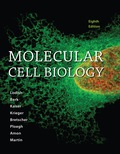
To write:
To discuss the differences between the normal and cancerous cells.
Introduction:
Cancer cells are found as very different from the normal cells in terms of size, shape, and organization. These cells are known as abnormal cells because they have abnormal features of the division.
Explanation of Solution
Some of the common differences between the cancerous cells and normal cells are the following:
Normal cells stop growing (reproducing) when enough cells are present bu cancerous cells keep on dividing. Cancer cells don't communicate with other cells as normal cells do. Normal cells keep on communicating with nearby cells.
Normal cells get when they are damaged or get old. Cancer cells are not repaired or do not undergo apoptosis. Normal cells secrete substances that make them stick together in a group. Cancer cells do not stick together. Normal cells perform the specialized function, whereas cancer cells may not be functional. Normal cells stay in a specific area, For example, lung cells remain in the lungs.
Cancer cells, due to lack of adhesion molecules that cause stickiness, are able to travel via the bloodstream and lymphatic system to other regions of the body. They have the ability to metastasize. Normal cells reproduce themselves and then stop when enough cells are present. Cancer cells reproduce rapidly before the cells have had a chance to mature. Normal cells mature. Cancer cells, because they grow rapidly and divide before cells are fully mature, remain immature.
Thus, there is a number of differences found between the cancerous cells and normal cells.
Want to see more full solutions like this?
 Human Anatomy & Physiology (11th Edition)BiologyISBN:9780134580999Author:Elaine N. Marieb, Katja N. HoehnPublisher:PEARSON
Human Anatomy & Physiology (11th Edition)BiologyISBN:9780134580999Author:Elaine N. Marieb, Katja N. HoehnPublisher:PEARSON Biology 2eBiologyISBN:9781947172517Author:Matthew Douglas, Jung Choi, Mary Ann ClarkPublisher:OpenStax
Biology 2eBiologyISBN:9781947172517Author:Matthew Douglas, Jung Choi, Mary Ann ClarkPublisher:OpenStax Anatomy & PhysiologyBiologyISBN:9781259398629Author:McKinley, Michael P., O'loughlin, Valerie Dean, Bidle, Theresa StouterPublisher:Mcgraw Hill Education,
Anatomy & PhysiologyBiologyISBN:9781259398629Author:McKinley, Michael P., O'loughlin, Valerie Dean, Bidle, Theresa StouterPublisher:Mcgraw Hill Education, Molecular Biology of the Cell (Sixth Edition)BiologyISBN:9780815344322Author:Bruce Alberts, Alexander D. Johnson, Julian Lewis, David Morgan, Martin Raff, Keith Roberts, Peter WalterPublisher:W. W. Norton & Company
Molecular Biology of the Cell (Sixth Edition)BiologyISBN:9780815344322Author:Bruce Alberts, Alexander D. Johnson, Julian Lewis, David Morgan, Martin Raff, Keith Roberts, Peter WalterPublisher:W. W. Norton & Company Laboratory Manual For Human Anatomy & PhysiologyBiologyISBN:9781260159363Author:Martin, Terry R., Prentice-craver, CynthiaPublisher:McGraw-Hill Publishing Co.
Laboratory Manual For Human Anatomy & PhysiologyBiologyISBN:9781260159363Author:Martin, Terry R., Prentice-craver, CynthiaPublisher:McGraw-Hill Publishing Co. Inquiry Into Life (16th Edition)BiologyISBN:9781260231700Author:Sylvia S. Mader, Michael WindelspechtPublisher:McGraw Hill Education
Inquiry Into Life (16th Edition)BiologyISBN:9781260231700Author:Sylvia S. Mader, Michael WindelspechtPublisher:McGraw Hill Education





